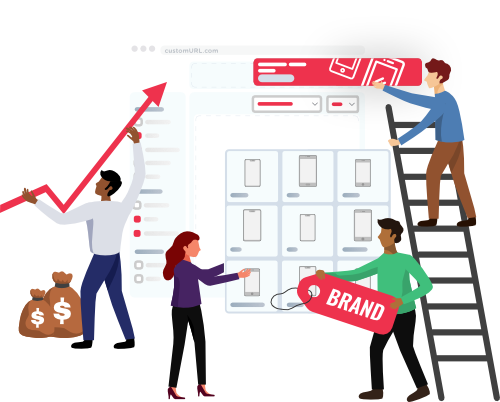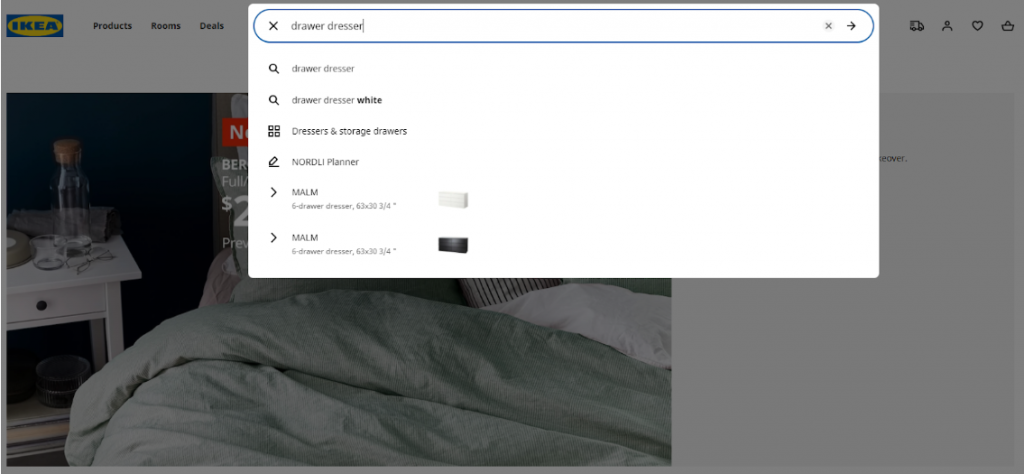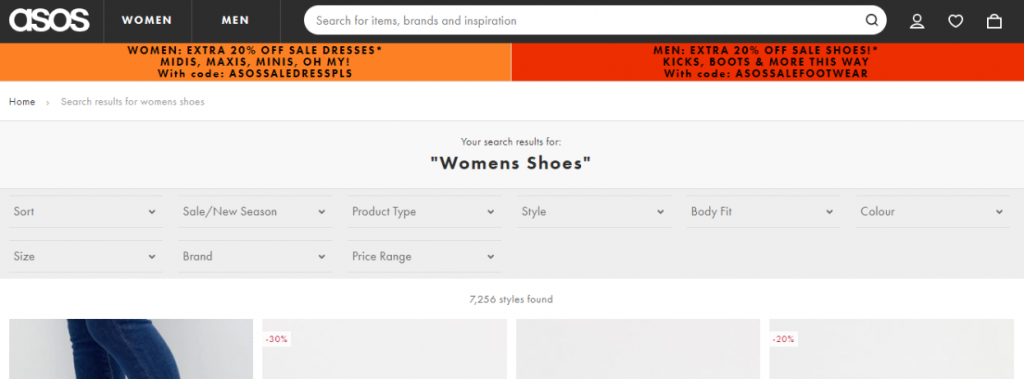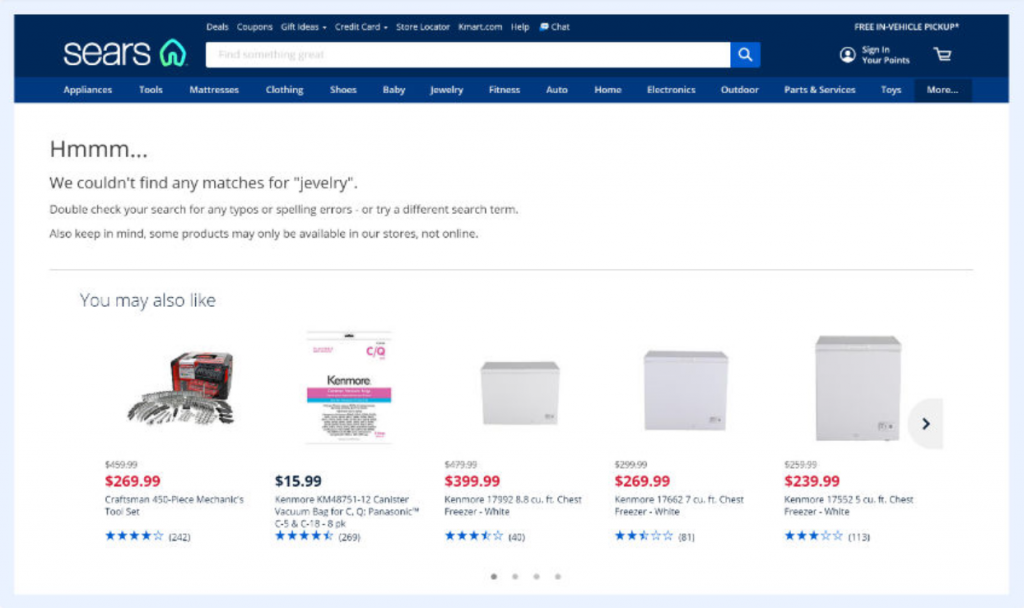13 Searchandising Strategies To Generate More Revenue For Your eCommerce Business
Promoting products offline is a common and successful business practice.
But for online businesses, this is often neglected, because it can be difficult to help shoppers navigate to promotions. This guide will teach you how to effectively leverage searchandising on your webshop to increase revenue.
You’ll find out:
- How to transform your result pages to increase your revenue,
- How you can offer exact products in real-time, like autocomplete,
- And which factors should impact your searchandising strategy.
Ready to start?

Think about how often people use the search bar on a site, be it a news site, an online store, a social platform or a message board. I bet nearly every visit.
As Econsultancy puts it:
“Typically, up to 30% of visitors will use the site search box, and each of these users is showing a possible intent to purchase by entering product names or codes.“
This means that your search can make or break the success of your business. Your search function gives you a great opportunity to apply marketing and sales tactics to your search pages.
- What is Searchandising?
- The Process of Effective Searchandising
- Searchandising Strategies
- 1. Boosting Products: new arrivals, on-brand products
- 2. Custom collections and bundles
- 3. Boosting your highest-margin products
- 4. Embedded Product Listings (Autocomplete on Steroids)
- 5. Promotional Banners Near the Search Bar
- 6. Promotional Badges
- 7. Optimizing and Re-ranking Product Results
- 8. Personalized Result Optimization
- 9. Personalize Your Category Pages
- 10. Boost Products Based on Availability
- 11. NLP Autocomplete
- 12. No-result Pages
- 13. Updating product catalogs
- Summary
What is Searchandising?
In traditional brick-and-mortar stores, merchandising is basically the practice of guiding the shoppers’ attention to the offers and products they want them to notice.
This can be done in a large number of ways – hanging signs, rearranging the products on the shelf or the entire store, putting price tags with different colors on items that have a discount, and so on.
In eCommerce, there are many different ways to do this: putting large CTAs on your site, colorful offers above-the-fold on your main page, pop-up windows, and so on.
Where eCommerce merchandising becomes difficult is on the search page. Banners or pop-ups are not going to be very effective if a customer has a specific product in mind and is actively using the search bar to find it.
And this is where the power of search + merchandising, searchandising for short, comes into play.
As with every online marketing and sales process, searchandising isn’t a single step, but a whole process.
Let’s look at it now.
The Process of Effective Searchandising
There are three very basic golden rules of searchandising.
- Understand your business’ basic priorities and goals. This will help you choose from the abundance of searchandising strategies available, many of which we describe in this article – and their potential benefits for your business.
- Have your KPIs ready. As with all business decisions, you should know what metrics you want to use to measure your success or failure. When using searchandising, click-through rate, conversion rate, average order value can all be important. But also, to better define what products and offers to showcase, you have to know your profit margins, inventory, and availability.
- Implement, watch closely, monitor, and refine. Monitor the performance of the rules you set, and fine-tune your strategy as you go. Incorporate searchandising analytics and decisions in your regular meetings and brainstormings, and define intervals for changing up things.
Does this all sound a little vague? Don’t worry.
Here are 13 very specific things you can do…
Searchandising Strategies
In this section, we’ll show you some specific ways to highlight promotional offers to your customers, while maintaining their sense of control over the search process.
Keep in mind: the goal is not to bombard the customer with offers until they give up and convert. It’s to find the best offer for them by paying attention to what they’re doing, and what they’re searching for.
Giving them what they want (even when they don’t know what that is), helps create grateful customers who are likely to return to your store for future purchases.
To do this, the first thing you want to do is…
1. Boosting Products: new arrivals, on-brand products
Simply placing certain products on the top of the results page can be successful, but it’s important you make sure it benefits your customers.
When selecting products to move to the top of the results page, make sure they’re relevant, popular and are something your customer wants to buy.
This is a great thing to do with new models or products.
Think about this: by searching for something specific, shoppers might miss a better, upgraded version, or they might not know a new product is available, so when you highlight a relevant, related product the benefit is clear.
If you have your own brand products, you might also want to showcase these first.
We recommend you do this when these products are already preferred by your customers, validated by positive feedback, and you have clearly defined unique benefits that the competition doesn’t.
2. Custom collections and bundles
A great way of creating a cohesive shopping experience while guiding your customers toward different products, is to not just place solitary products in front of them.
Creating custom collection offers can be particularly effective during holidays and special events.
To do this, pick items that are especially popular during these periods or are frequently purchased together..
Then create Christmas bundles, Super Bowl offers or anything you want.Display these when your user includes the relevant keywords in their search query (like “christmas”). By displaying these bundles beside the product results, you retain relevance while guiding shoppers’ attention toward other products you can upsell and cross sell.
3. Boosting your highest-margin products
It makes sense to tweak your results pages in a way so that your best high-margin products are displayed first – as products at the top of the page are purchased more frequently.
If you decide to boost products this way, make sure to monitor user behavior as this method can backfire. Keep an eye on your click and conversion rates, because altering results in this way can create a negative search experience and hurt your business in the long term.
4. Embedded Product Listings (Autocomplete on Steroids)
Suggesting keywords and phrases that your customer might be interested in, while they are still typing, is a great way to increase conversions.
Why not take it a step further, and display products that best match the query right there in the suggestions field too?
You can often do this through searchandising functionality.Like faceted search, this is a real-time solution that can greatly reduce a shopper’s path-to-purchase, which improves their overall experience.

5. Promotional Banners Near the Search Bar
Banners may not be as popular as they once were, but if used correctly, they can still be powerful tools in increasing conversion rates.
Placing banner near the search bar and at the top of the results page effectively directs your customers’ attention to the categories, products, or discounts you want them to check out.

6. Promotional Badges
Adding badges is a great way to communicate discounts to customers without interrupting their shopping experience.
It’s one of the basic and most effective merchandising methods because you don’t have to alter the search rankings in any way.
You can use badges to announce:
- New product arrivals
- Upgrades or new available products (e.g. new colors or sizes for clothes)
- Available-in-bundle offers
- Limited-time discounts
- Last-chance products or sales
For a simple example, look at how Google clearly indicates which pictures are licensable when you perform an image search.

7. Optimizing and Re-ranking Product Results
When your eCommerce store has many products, most search queries yield dozens or even hundreds of equally relevant results.
In order to effectively guide shoppers to the products they’re looking to buy, the next thing you should do is set up additional ranking rules to display the most popular and relevant products first.
However, with searchandising, you can edit these ranking rules any way you want.
For example, you can choose to display relevant products that are on sale at the top of the search results page, in order to quickly clear out your stock.
Or, you could opt to show your own brand of products first. Whatever you decide to do though, make sure that you keep relevancy and popularity as important criteria, so you don’t disrupt the shopping experience too much.
8. Personalized Result Optimization
Continuing that thought, what you should also take into account with ranking is the behavior of the given customer on your site.
If the customer has searched for men’s sneakers before, you could direct them to other men’s sportswear.
Try to avoid the mistake that many retargeting campaigns make and don’t offer the customers the same exact thing that they previously bought.
This way, you provide a better shopping experience to the customer while increasing your cross-sell and up-sell opportunities.
9. Personalize Your Category Pages
Category pages are useful for shoppers who have some kind of idea of what they’re looking to buy, but aren’t looking for an exact product.
By adding elements of personalization to these pages, you can quickly increase your conversion rate.
As a pro move, personalize these pages based on personal preferences, behavior and their search intent – these yield the most relevant results.
10. Boost Products Based on Availability
One of the main things to consider when boosting products is their availability.
If you have a lot of a particular product in stock and want to move them quickly, boost them on the results page.
However, if you have new arrivals and releases that are not yet in your inventory, you could also boost them so you can achieve nice pre-sales numbers.
This is a highly effective strategy if you are using a search that ranks products based on popularity.
New products don’t yet have the clicks and purchases to boost them to the top of the results page, so if you know they’re going to be a hit, you can adjust the positioning to get them in front of shoppers immediately.
11. NLP Autocomplete
As we wrote in our previous article, 12 Best Machine Learning Strategies for eCommerce Businesses, natural language processing is an essential part of any site search solution.
Here’s why:
Natural language processing and machine learning have to understand the kind of language and phrases your customers use, how often they use them, if the results are satisfactory for those phrases, and even common typos along with the correct spelling.
This way, every user can feel that the search engine is truly there to help and pays attention to the smallest details, all without being annoying.
Using the same language as your customers automatically improves any search function while providing a subconscious positive affirmation for the user about the usability and overall the customer experience of your site.
Oftentimes, you can also boost product and keyword suggestions in your autocomplete search, while taking into consideration NLP relevancy.
12. No-result Pages
Your no results pages present a huge opportunity to direct attention of the customers.
While there might be 0 results for precisely what they’re looking for, you can use this opportunity to promote other, relevant products or things like: your current discounts and bundle offers, the most popular products (even better when personalized) or simply the products you want to move.For more advice regarding how to design no-result pages, take a moment and check out these 12 Awesome “No results found” Pages!

13. Updating product catalogs
Make sure your product catalogs continually stay up-to-date. Without accurate products and attributes, it’s nearly impossible to provide shoppers with a good search experience – whether or not you leverage searchandising!Look for merchant tools that allow you to easily update your product catalogs. Batch updating attributes is the easiest way to do this.
Summary
Searchandising is not actually that hard to do – however, you have to know what you are doing, and why.
The key takeaways from this article if you are looking for searchandising techniques that will definitely improve your conversion rates are these:
- Personalize: always pay attention to the history and behavior of your users, not just their location and demographics. Try to give them what they actually want, direct their attention in a way that is useful for them.
- Use Search Rules: don’t just trust the algorithm to make the choices for you. You have your business plan, your cash flow, your inventory to consider, marketing campaigns that are set, holidays that are coming up. Based on these, make the rules yourself, and tweak the results just enough to make the most of your offerings.
- Recommend Products: don’t be shy to suggest similar or discounted products. Put them in bundles or packages if you have to, but keep in mind that while you don’t want to be annoying, you definitely have to be a salesman. Define what and when to recommend that your customers will be grateful for.
- Run Search Campaigns: besides your everyday sales and marketing campaigns, come up with creative ways to offer upsell or cross-sell right on your search result pages.
- Track Data & Measure Results: once you have set the rules, start to watch them work. If they don’t, try other ones. Always base your decisions on the data that you see on your dashboards, and not gut feelings. Data-based decisions are the ones that will help you scale your business.
If you listen to the eCommerce Search Best Practices and base your decisions on the data about what your users like and what they don’t, you will increase key metrics like conversion, average order value, retention, and more.


